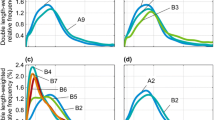The formation number of multilayer fibrous composite materials such as paper and cardboard comprises an important indicator for evaluating product quality, ensuring a degree of perfection in the mass preparation technology, as well as determining forming equipment and the quality of raw materials. The main disadvantages of the existing methods for determining the formation number involve the impossibility of separately evaluating the variations in the formation of each layer and the limitations inherent to instruments for testing thick materials. These disadvantages can be eliminated by the proposed method for analyzing the microstructure of the cross-sectional cut of a multilayer fibrous composite material. According to this method, formation quality is evaluated by an indicator inversely proportional to the look-through index representing the result of a statistical analysis of the vertical-plane size distribution of floccules (fiber clusters) in the cross section of each layer and the board as a whole. By analogy with the diagrams of the distribution of the brightness of the light transmitted through a fibrous material, uniformity diagrams of the floccule size distribution in the vertical plane are applicable for evaluating the quality of formation of each layer separately as well as the board as a whole.






Similar content being viewed by others
References
A.S. Smolin A.S., B.K. Dubovyi, et al., Corrugated Board Technology, Textbook, Ed. 2nd, Rev. and Add. [In Russian], Publ. Poligrafich. assotsiatsiya vuzov, Saint Petersburg (2019).
A.N. Romanova, Ya.B. Kazakov, and A.B. Malkov, Izv. Sankt-Peterburgsk. Lesotekhnich. Akademii [In Russian], Iss. 227. 293-306 (2019).
B.B. Abramova, Development of a Method for Evaluating the Variations in the Formation of the Macrostructure of Paper [In Russian], Dis. Cand. Sci. (Tech.), Lomonosov Northern (Arctic) Federal University, Arkhangelsk (2017). URL: https://narfu.ru/upload/iblock/fe9/Abramova-VV-dissertatsiya.pdf
A.B. Rudalev, A.I. Popov, et al., A program for Visualization and Analysis of the Uniformity of Forming the Macrostructure of Paper and Board (PaperForming) [In Russian], Certificate of registration No. 2013619551, Register Date: 10/09/2013.
SCAN-P 92:09 Accepted 2009 Paper and board Betaradiation-Based Grammage Formation Measurement - Point Source Method, SCAN-test Methods are issued and recommended by FFIF, PFI and INNVENTIA for the pulp, paper and board industries in Finland, Norway and Sweden. Distribution (2009).
Machines for the Production of Paper and Board [In Russian], Ed. V.S. Kurov and N.N. Kokushin, Publ. Politekhn. Un-ta, St. Petersburg (2017).
GOST 10700-97. Waste paper and board. Technical specifications [In Russian].
DIN EN 643 2014-11. European List of Standard Grades of Paper and Board for recycling, Technical Committee CEN/TC 172, Pub. Nov. (2014).
M.B. Banchakov, A.B. Kuleshov, et al., Wastepaper Processing Technology and Equipment. Part I [In Russian], HSE SPbGUPTD, St. Petersburg (2019).
N.P. Midukov, Yu.A. Lyalin, et al., Khimiya Rastit. Syrˆ ya [In Russian], No. 4, 109-112 (2019).
J. Clark, Cellulose Technology (the Science of Pulp and Paper, Pulp Preparation, Processing it into Paper, Test Methods) [In Russian], Trans. from English by A.V. Obolenskaya and G.A. Pazukhina, Lesnayaprom-st’,Moscow (1983).
B.I. Azarov, A.B. Burov, and A.B. Obolenskaya, Chemistry of Wood and Synthetic Polymers, Textbook, Ed. 2nd, Rev. [In Russian], “Lan”, St. Petersburg, (2010).
A.S. Smolin and E.L. Akim, Fiber Chemistry, 50, No. 4, 336-344 (2018).
M. Fan, D. Dai, and B. Huang, Fourier Transform Infrared Spectroscopy for Natural Fibers, Fourier Transform - Materials Analysis, Ed. Dr Salih Salih (2012). URL: http://www.intechopen.com/books/fourier-transformmaterials-analysis/fourier-transform-infraredspectroscopy-for-natural-fibres
T. Shrainer, X. Grossmann, et al., Khimiya Rastit. Syr’ya [In Russian], No. 4, 251-260 (2020).
N.P. Midukov, B.S. Kurov, et al., Pat. No. 2723972. A method for Preparing a Cross-Section for Controlling the Parameters of a Cellulose-Containing Material [In Russian], Publ. 06/18/2020, Bul. No. 17.
N.P. Midukov, Ya.V. Kazakov, et al., Fiber Chemistry, 52, No. 1, 51-57 (2020).
A.K. Khmel’nitskii, Upravlenie, Kontrol’ i Diagnostika [In Russian], No. 4, 54-56 (2011).
Author information
Authors and Affiliations
Corresponding author
Additional information
Translated from Khimicheskie Volokna, No. 2, pp. 59-63, March-April, 2021.
Rights and permissions
About this article
Cite this article
Kurov, V., Midukov, N. Evaluation of the Formation Quality of Multilayer Fiber Composite Material According to Cross-Sectional Cut Microstructure. Fibre Chem 53, 115–119 (2021). https://doi.org/10.1007/s10692-021-10250-w
Published:
Issue Date:
DOI: https://doi.org/10.1007/s10692-021-10250-w




